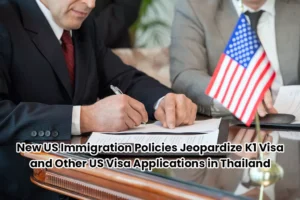Understanding the visa application process is essential for families looking to bring their children to the USA. This guide offers straightforward information to Thai partners of American citizens who have Thai children and wish to apply for a K-2 visa.
Bringing your Thai child/children over to the United States involves several steps, and this article aims to simplify them. Whether you are just starting to explore the possibility of moving to the US or are ready to instigate the application process, this guide is tailored to provide you with the necessary insights and directions. By focusing on the specific needs and concerns of Thai-American families, we hope to make your path to obtaining a K-2 visa as simple as possible.
What is a K-2 Visa?
A K-2 visa exists as a special category of non-immigrant visa, designed to unite families during immigration. It grants the child/children of a K-1 fiancé(e) visa holder, typically a Thai partner of an American citizen, entry into the United States. This visa allows the child/children to accompany their Thai parent, acting as a critical link in the chain of family-based immigration, ensuring that children do not have to face separation from their parents when needing to move.
The process of obtaining a K-2 visa is closely tied to the K-1 visa, issued to the foreign-citizen fiancé(e) of a US citizen. The K-2 visa ensures that children under the age of 21 and unmarried can join their parents to experience a new life in the United States. It acknowledges the importance of keeping families together and provides a legal and structured pathway for children to be able to unite with their parents. This visa category reflects the US immigration system’s recognition of the value of family unity, especially in the context of cross-cultural unions and the diverse family structures they create.
Eligibility for a K-2 Visa
To qualify for a K-2 visa, there are specific eligibility requirements that must be met, ensuring that the visa process aligns with US immigration policies and family reunification goals.
Here is a concise list of the eligibility criteria for a K-2 visa:
- Age Requirement: The child must be under 21 years old. This age limit is strictly adhered to, emphasizing the visa’s focus on helping minor children accompany their parents.
- Marital Status: The child must be unmarried. Marriage would change the child’s eligibility status, as the K-2 visa is specifically designed for dependent children.
- Relationship to the K-1 Visa Holder: The child must be the biological or legally adopted child of the K-1 visa applicant. This requirement ensures that the visa is used for its intended purpose of family reunification.
- Parent’s K-1 Visa Status: The K-2 visa application is contingent on the parent’s K-1 visa application. The child can only apply for the K-2 visa if their parent has applied for or has been granted a K-1 visa.
- Intent to Immigrate: The child must intend to immigrate to the U.S. with their parent. The K-2 visa is not a tourist visa but a step towards permanent residency in the U.S.
- Financial Support: There should be evidence that the child will be financially supported in the U.S. This is often demonstrated through the financial documents of the American citizen fiancé(e).
- Medical Examination: The child must undergo a medical examination as part of the visa process, ensuring they meet the health standards required for U.S. immigration.
Step-by-Step Guide to Applying for a K-2 Visa
After their child and their parents meet the eligibility requirements, the next step would be to apply for the actual visa:
- K-1 Visa Application: The process begins with the American citizen partner applying for a K-1 visa. This is the first step and must be completed before applying for a K-2 visa.
- Gather Necessary Documents: Essential documents include the child’s birth certificate, passport, and photographs. If applicable, adoption papers or custody documents are also needed.
- Complete Form DS-160: The next step is to fill out Form DS-160, the Online Nonimmigrant Visa Application. This form is available on the US Department of State website.
- Pay the Visa Fee: After completing the form, you will need to pay the visa application fee. Keep the receipt as proof of payment.
- Schedule an Interview: Once the fee is paid, schedule a visa interview at the US Embassy or Consulate in Thailand.
- Prepare for the Interview: The interview is a crucial part of the process. Prepare your child by discussing what to expect and gathering all necessary documents.
- Attend the Visa Interview: During the interview, a consular officer will determine if your child is eligible for the visa. Honesty and clarity in your responses are key.
- Wait for Processing: After the interview, the application will be processed. Processing times vary, so patience is necessary.
- Receive the Visa: Once approved, the visa will be placed in your child’s passport.
After Receiving the K-2 Visa
Upon receiving the K-2 visa, there are important steps to follow:
- Travel with the K-1 Parent: The child must travel to the US with or after the K-1 parent. They cannot travel before the K-1 parent.
- Adjustment of Status: After arriving in the US, you must apply for an Adjustment of Status for your child to become a lawful permanent resident.
- Follow US Immigration Rules: It’s important to follow all US immigration rules to maintain legal status.
Conclusion
The process of applying for a K-2 visa, while detailed, can be circumvented successfully with careful preparation and a clear grasp of the mandatory steps. While the journey may appear complex at first, understanding each phase can make it more approachable and less overwhelming. It’s essential to remember that every family’s situation is unique, and specific circumstances might require tailored advice. Therefore, consulting with a legal expert or immigration professional is advisable for personalized guidance. Their expertise can provide invaluable support, ensuring that your family’s transition to life in the US is as smooth and worry-free as possible.
Contact Siam Legal
 | Ken Graham US Immigration Attorney Partner, Siam Legal International |
 | Natdaphon Luengsawang Senior US Visa Consultant Siam Legal International |
LIVE SUPPORT
 CALLCall (702) 799 9719 |  CHATChat with our representative | |
| From US: Sunday – Friday 5:00 PM – 7:00 AM (New York time) 2:00 PM – 4:00 AM (Los Angeles time) From Thailand: Monday – Friday | ||








































